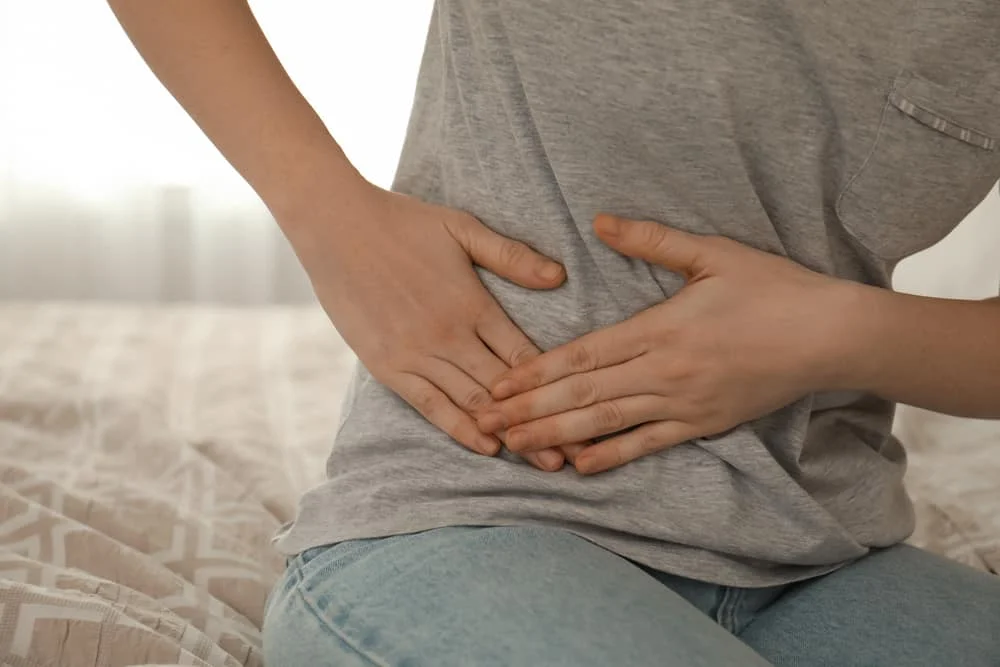A Cesarean section, commonly referred to as a C-section, is a significant abdominal surgery. Like all surgeries, it requires time for the body to heal. Notably, the procedure involves cutting through various layers, including nerves, which can take about six months or even longer to heal completely. Many women report feeling sensations like numbness, tingling, and sharp, shooting pains long after the delivery.
The postpartum period refers to the first six weeks following delivery. It is during this phase that the body works to return to its pre-pregnancy state. While it’s common knowledge that new mothers might feel tired after childbirth, many do not anticipate continuing to experience postpartum abdominal pain. In this guide, we’ll delve into the different types of pain one might experience and what could be causing them.
Experiencing Sharp Stabbing Pain on the Right Side After a C-Section?
While pregnancy prominently displays external transformations, the internal shifts aren’t as visibly evident. However, the repercussions of these internal changes are distinctly noticeable. During a C-section surgery, surgeons aim to minimize any nerve damage. Yet, navigating through the layers of the uterus without slightly affecting the nerves is challenging.
Therefore, if you’re experiencing a sharp, stabbing pain on the lower right side of your abdomen following a C-section, it’s essential to understand that this discomfort can often be attributed to nerve disturbances caused during the procedure. While it’s a common post-operative sensation, always consult with your healthcare provider to ensure there are no complications.
Understanding the Causes of Pain Post C-Section
A C-section delivery, in contrast to vaginal delivery, involves a surgical procedure where incisions are made in both the abdomen and the uterus. Such an intervention can be strenuous and traumatic for the body.
The recovery period following a C-section often spans several months, and the journey can be more challenging if accompanied by various pain sensations. Now, let’s delve deeper into the reasons behind the sharp stabbing pain that some women experience after a C-section:
1. Afterpains
After childbirth, one of the most common discomforts women experience is “afterpains”. These are cramps that arise as the uterus contracts to return to its pre-pregnancy size. The magnitude of these contractions can be likened to menstrual cramps but can intensify during breastfeeding. While the intensity peaks during the initial postpartum week, they typically subside in the subsequent weeks.
2. Constipation
Postpartum abdominal pain can also be attributed to constipation, often intensified by cramps. Several factors contribute to constipation after delivery:
- Hormonal Fluctuations: Elevated progesterone levels.
- Dietary Choices: A diet deficient in fiber.
- Stress: The overall strain of childbirth and adjustments thereafter.
- Medication Side Effects: Pain relievers prescribed post-surgery can slow down metabolism, leading to constipation. It’s important to note that constipation is a frequent concern during pregnancy, and its continuation postpartum is often exacerbated by certain medications.
3. Scar Tissue Formation
As the surgical site heals, scar tissues form. These can occasionally tug at surrounding tissues, causing sharp pains.
4. Wound infection post Cesarean
Wound infection after a c-section involves internal and external infections. These infections can also lead to septicemia, which is a scarce type of infection.
5. Internal Healing
The incisions made during the surgery need time to heal. As the internal tissues repair, they can sometimes cause discomfort or stabbing pain sensations.
6. Internal infections
Surgical procedures expose the inner anatomy to external environments. Despite utmost precautions, there’s always an inherent risk of infections post any surgical intervention. In the context of a C-section, microbes can swiftly infect the exposed tissues. Preventive antibiotics are often administered to mitigate such risks.
7. External infections
The incision site is particularly susceptible to infections. Symptoms like redness, swelling, or pus formation at the wound site signify an external infection, necessitating immediate medical attention.
8. Septicemia
Among the most severe postoperative complications is sepsis or septicemia. Although rare, it’s life-threatening. Symptoms include high fever, rapid heartbeat, and breathing difficulties. It’s imperative to seek urgent medical intervention if such symptoms manifest.
Sharp stabbing Pain on Left side After C-Section
Experiencing Pain After a C-Section The aftermath of a C-section can bring about various forms of discomfort. Notably, the sharp pain on the left side or around the incision area is often due to nerve sensitivity. This stabbing pain is generally an outcome of nerve damage during the procedure. Fortunately, medical interventions such as nerve blocks and specific medications can effectively alleviate this pain.
Nerve Pain Post C-Section
The surgical incision required for a C-section necessitates cutting through layers of tissue, which inevitably affects nerves. While the body typically undergoes a natural healing process, the resultant pain often manifests as burning, stabbing, or shooting sensations in the abdomen. Intriguingly, these sensations may sometimes intensify with fluctuating weather conditions.
Classifying Nerve Pain The body’s intricate nerve system ensures various functionalities. When damaged, these nerves can give rise to a spectrum of symptoms, either short-term or chronic, contingent upon their roles.
Superficial Pain:
If you encounter intensified pain around your scar’s periphery, it signals damage to specific nerves: the ilioinguinal, ili hypogastric, and genitofemoral nerves. Characterized by burning sensations and heightened sensitivity, this pain is a foreseeable consequence of the surgery. Over time, with appropriate medication, this pain typically recedes as the nerves heal.
Nerve Injury:
While surgeons employ utmost precision during C-sections, the procedure’s very nature poses risks. Nerves proximal to the incision site, such as the ilioinguinal or genitofemoral, are particularly vulnerable. If you discern pain distinct from the superficial type, it might indicate more profound nerve injury. One prevalent approach to address this is the nerve block method.
By introducing an anesthetic to induce temporary numbness in the affected nerve, pain relief can be gauged. If the numbness is accompanied by pain relief, it often signifies peripheral nerve damage. Conversely, persistent pain despite the numbness suggests alternative underlying issues.
Navigating Nerve Damage Post C-Section
Nerve injuries, albeit uncommon, can indeed occur during pregnancy and childbirth. However, it’s crucial to understand that these injuries are not necessarily inevitable and can be prevented and treated effectively if they do occur.
Identifying Symptoms of Nerve Damage: If nerve damage transpires following a C-section, several indicative symptoms can emerge, which are crucial for diagnosis and subsequent treatment. Some of the significant symptoms include:
- Numbness: A distinct loss of feeling or sensation in particular areas of the body.
- Muscle Weakness: A noticeable reduction in the strength of specific muscle groups, impacting mobility and function.
- Motor Impairment: Hindered or altered motor functions, often leading to coordination and movement issues.
- Bowel and Bladder Dysfunction: Complications related to the control and function of the bladder and bowel systems.
- Pain in Lower Extremities: Pain that is localized in the lower sections of the body, including areas like the pelvis, hip, thigh, knee, leg, ankle, and foot.
Other Pains After C-Section
Pain In the Right Hip After C-Section
Experiencing pain after a C-section is expected, given the surgical nature of the procedure. Among the variety of discomforts, a sharp pain in the right hip can be particularly concerning for many women.
Root Causes:
- Tissue Binding: During the healing process post-surgery, damaged tissues may adhere to the neighboring tissues, which can result in pain. This adhesion, sometimes referred to as internal scarring, can trigger discomfort not only in the abdominal area but also in the back and hip regions.
- Weight Factors: Pregnancy typically results in weight gain, which can exert extra pressure on the hips. Especially after a C-section, where physical activity might be restricted for a while, there might be challenges in losing this added weight promptly. This additional weight can stress the right hip, causing pain.
Suggested Remedies:
- Nutritional Boosters: Incorporating specific nutrients into the diet can potentially expedite the healing process. Vitamin C, known for its tissue repair properties, and iron, essential for red blood cell production, can be beneficial.
- Weight Management: Gradually adopting a balanced diet and engaging in light exercises, as recommended by healthcare providers, can aid in shedding the extra pregnancy pounds. This can alleviate the strain on the hips and reduce pain.
While some level of discomfort is anticipated after a C-section, persistent or severe hip pain should not be ignored. It’s essential to consult with a healthcare professional to ensure proper diagnosis and treatment, ensuring a smoother postpartum recovery journey.
Pain In Stomach and Lower Right Abdominal After C-Section
With a c-section, it is normal to have sharp pains in the right side. The hormone called oxytocin helps in stretching the uterus and it is also released while you breastfeed your child. These hormones cause contractions which is one of the reasons for stomach and abdominal pains.
if cramping and contractions are not the issues of your discomfort then you might be suffering from irritation of the ilioinguinal nerve. This might cause extreme pain in your lower abdominal and pelvic area into the groins and genitals. This problem is caused due to the damage ilioinguinal nerve. You must consult with your doctor to get rid of this problem.
Sharp Pain in Right Rib After C-Section
Experiencing tightness on the right side of the rib cage and between the shoulder blades post a C-section can be quite concerning. One potential culprit behind this discomfort is a condition called cholelithiasis, which refers to the formation of gallstones.
Cholelithiasis can manifest due to increased levels of hormones like estrogen and progesterone during pregnancy. Notably, there’s an estimated 12% likelihood of older pregnant mothers developing gallstones. Factors heightening the risk include:
- High-fat diets
- Insulin resistance
- Obesity
To mitigate the risk of developing gallstones, it’s advisable to:
- Adopt a low-fat diet
- Limit intake of high-cholesterol foods
- Enhance physical activity.
Always consult with a healthcare professional if you experience persistent pain or any unfamiliar symptoms post-delivery.
Conclusion
Sharp stabbing pains after a C-section can be unsettling, but it’s essential to remember that these sensations can be a common part of the post-operative experience. The intensity and type of pain may vary among individuals based on various factors. If you’re grappling with such discomfort, take heart in knowing you’re not alone. But for your peace of mind and wellbeing, it’s crucial to consult with your doctor to address any concerns or complications promptly. Your health and comfort during the recovery process are paramount.
Medical Disclaimer: This content is for informational purposes only and not a substitute for professional medical advice. Always consult your physician for medical concerns. Relying on this information is at your own risk
Disclaimer: The content on Wellness Derive is for informational purposes only and not a substitute for professional medical advice, diagnosis, or treatment. Always consult a healthcare provider for medical concerns.



